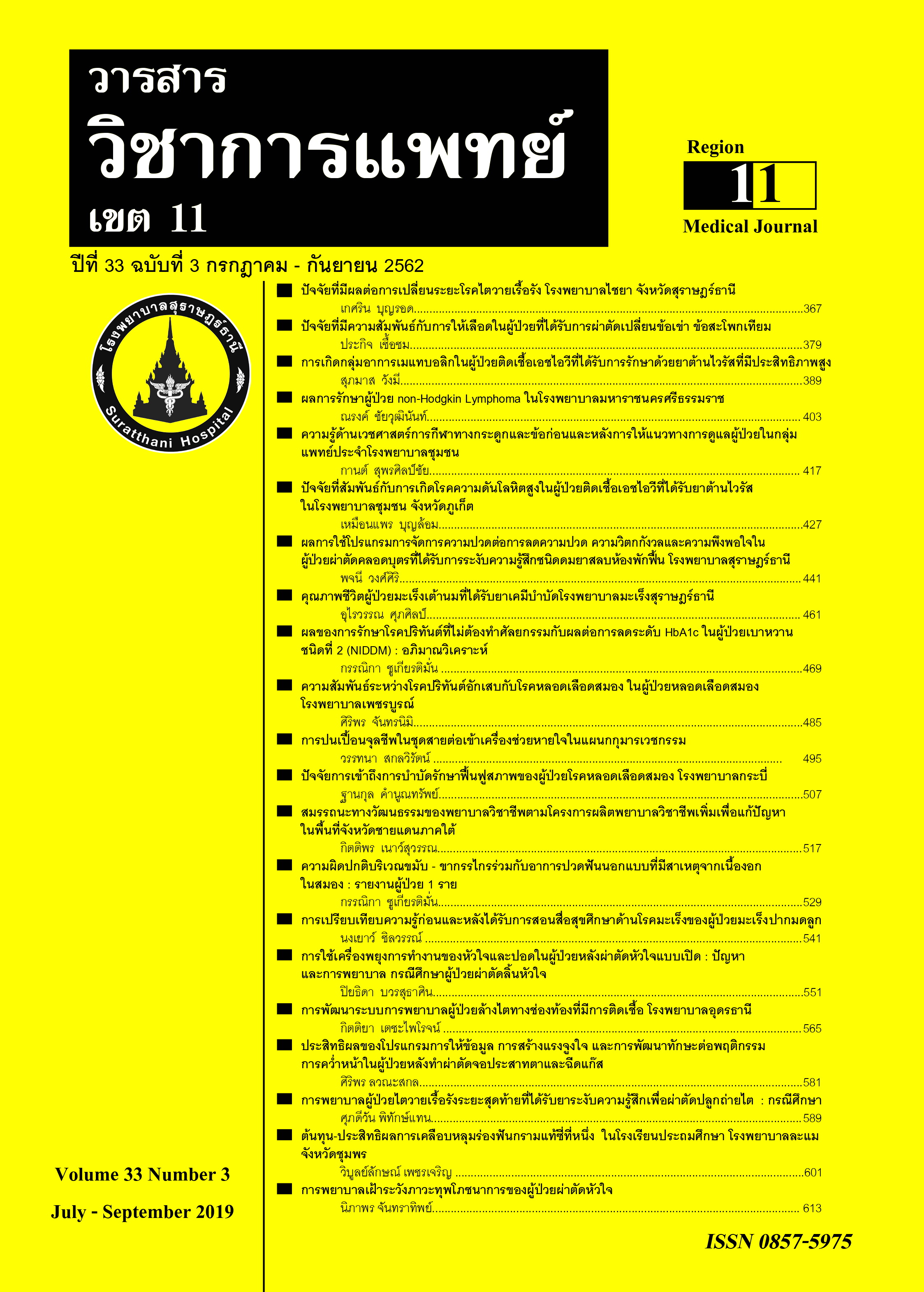The metabolic syndrome in patients infected HIV who receive HAART
Keywords:
Metabolic syndrome, HIV patients, Highly Active Antiretroviral TherapyAbstract
This study was a descriptive research by retrospective study to investigate the prevalence and pattern of metabolic syndrome in HIV-infected patients receiving treatment. Highly effective antiretroviral therapy for at least 6 months. Of Lamae Hospital Data from the HOS xP program and from the patient history show that HIV-infected patients receiving high-dose antiretroviral therapy Mostly female. Marital status Age between 41-50 years old. farmers
Used to smoke / drink Duration of HAART regimen 7-8 years CD4, the first 1-100 cells / mm3 CD4 last 401-500 cells / mm3, the high efficacy of antiretroviral therapy for metabolic syndrome. GPOVIR Z250 (54.89%), followed by GPOVIR S30 (21.20%), had a high level of triglyceride (50.70%) and fat The most common adverse event was hyperthyroidism (50.00%). High blood pressure (23.20%) and high blood glucose (7.70%), respectively, were consistent with those of Pujari et al., 2005, Sujitra Buddhawong and colleagues (2004) Bergersom et al., 2006; Samaras, et al., 2007, but not consistent with Nguemaim et al., 2010. Because of this study, the antiretroviral regimen with Nevirapine High cholesterol, high sugar, low HDL cholesterol. TDF + 3TC (150) + EFV (600) and TDF + 3TC (150) +
NVP (200) (1.09%). The results reflect the severity of these complications in Thai patients receiving high-dose antiretroviral therapy. This study was conducted to determine the efficacy and safety of antiretroviral regimens in the prevention of cardiovascular disease in the long-term. NCEP ATP lll. Waist circumference (male> 102 cm, female> 88 cm) in the same patient. And to study the relationship between high-performance antiretroviral (NCEP) and metabolic syndrome (NCEP ATP lll). The sample size was higher than that in the provincial level.
References
Brown, T.T. Antiretroviral therapy and the prevalence and incidence of diabetes mellitus in the multicenter AIDS cohort study. Arch Intern Med 2005;165(10): 1179-84.
Carr, A. A syndrome of peripheral lipodystrophy, hyperlipidaemia and insulin resistance in patients receiving HIV protease inhibitors. AIDS 1998;12(7): F51-8.
Erb, P. Effect of Antiretroviral Therapy on Viral Load, CD4 cell count, and Progression to Acquired Immunode ficency Syndrome in a Community Human Immunodeficiency Virus-Infected Cohort. Arch Intern Med 2000;160: 1134-40.
Hammer, SM. A trial comparing nucleoside monotherapy with combination therapy in HIV infected adults with CD4 cell counts from 200-500 per cubic millimeter.
N Engl J Med 1996;335(15): 1081-90.
Jerico, C. Metabolic Syndrome Among HIV-Infected Patients. Diabetes Care 2005;28: 144-149.
Krentz, H.B., Kliewer, G. and Gill, M.J. Changing mortality rates and causes of death for HIV-infected individuals living in Southern Alberta, Canada from 1984
to 2003. HIV Med 2005;6(2): 99-106.
Palella, F.J. Declining morbidity and mortality among patients with advanced human immunodeficiency virus infection. N Engl J Med 1998;338(13): 853-860.
Seaberg, EC. Association between highly active antiretroviral therapy and hyperten-sion in a large cohort of men followed from 1984 to 2003. AIDS 2005;19(9): 953-60.
Torres, R.A. and Barr M. Impact of Combination Therapy for HIV Infection on Inpatient Census. N Eng J Med 1997;336: 1531-2.






